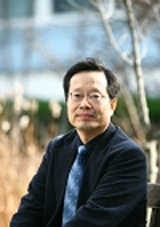
- 주소
B/D E6-4 #2104 (office), #2887 (lab), Department of Chemistry, KAIST, 291 Daehak-ro, Yuseong-gu, Daejeon, 305-701, Republic of Korea
- 전화
+82-42-350-2847 (office), 2887 (lab)
- 이메일
- 홈페이지
- 약력
- B.S., Chemistry, KAIST (1990.3 - 1994.2)
- M.S., Inorganic Chemistry, KAIST (1994.3 - 1996.2)
- Ph.D, Inorganic and Organometallic Chemistry, KAIST (1996.3 - 2000.2)
- Postdoctoral fellow, KASIT (2000.3 - 2002.9)
- Postdoctoral fellow, UC Berkeley c/o Prof. Peidong Yang (2002.10 - 2004.12)
- Assistant professor, KAIST (2005.1 - 2008.8)
- Associate professor, KAIST (2008.9 - 2013.12)
- Professor, KAIST (2014.1 - present)
연구실소개
Our laboratory that first started in 2005 mainly researches the syntheses of nanoparticles and their applications. We have synthesized gold, heterometallic nanostructures and metal/metal-oxide nanostructures by polyol process and thermolysis in solution phase. On the base of these acheivements, we are researching about surface modification and functionalization as well as sizes and shapes of gold nanoparticles. In addition, we are doing a variety of measurements about localized surface plasmon resonance and surface-enhanced Raman spectroscopy and theoretical calculation of each of the single metal particles for sensing applications. For the catalytic application of these nanoparticles, we have focused on the precise control of particle size, shape, and uniformity. For high catalytic efficiency, it is necessary to reduce metal particle sizes and thereby increase surface areas and active sites such as edges and kinks. The general form of heterogeneous catalysts is tiny metal particles embedded on silica and metal oxide supports, because highly active metal nanoparticles are effectively stabilized by supports having high surface area. The supports prevent the aggregation of the particles and in some cases, they form new active components on the interface with metals.
연구내용
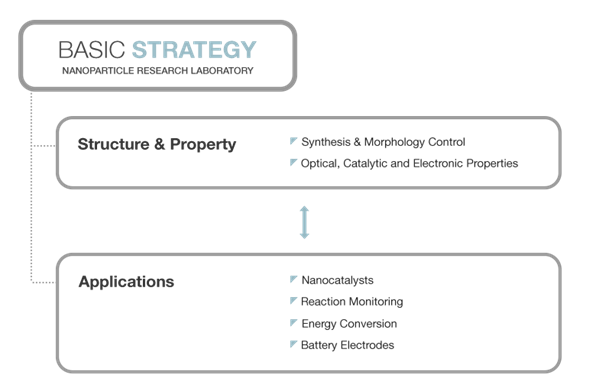
Research Purpose
NANOCATALYSTS FOR ENERGY PRODUCTION : From fundamental study of synthesis, morphology control, and property characterization to energy-related applications
Research topics
- Plasmonic nanocrystals for sensing and monitoring
- -Synthesis of plasmonic hybrid nanocrystals and study on plasmon-based optical and catalytic properties
- -Real-time reaction monitoring using single particle spectroscopy
- Photoactive catalysts for alternative energy generation
- -Establishment of uniform hybrid nanocatalysts and nanoreactors
- -Design of photoactive nanocatalysts for H2 generation and CO2 activation
- -Development of nanocatalysts for organic C1 chemistry such as C-C coupling
- Electroactive materials for storage and transport
- -Synthesis of metal oxide nanostructures for lithium ion battery anode materials
- -Metal nanoinks for high-resolution inkjet printing
- -Transparent electrodes and solar cell materials
연구성과
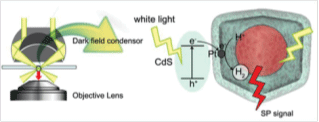
Plasmonic nanostructures such as gold nanoparticles are very useful for monitoring chemical reactions because their optical properties are highly dependent upon the environment surrounding the particle surface. Here, we designed the catalytic structure composed of platinized cadmium sulfide with gold domains as a sensitive probe, and we monitored the photocatalytic decomposition of lactic acid to generate hydrogen gas in situ by single-particle dark-field spectroscopy (D. Seo et al. J.Am. Chem. Soc. 2012, 134, 1221.)
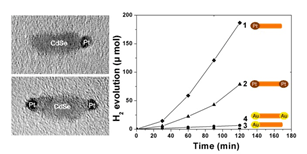
Photocatalytic hydrogen generation is one of the potential reactions for the production of environmentally clean and renewable energy resources from sun light. In the present work, we focused on geometrical (single- or double-tipped) and compositional (Pt or Au) variations of active metal components in a well-defined CdSe nanorod system. These colloidal nanostructures were employed for photocatalytic hydrogen generation from water under the identical reaction conditions with visible light irradiation. (J. U. Bang et al. J. Phys. Chem. Lett. 2012, 3, 3781.)
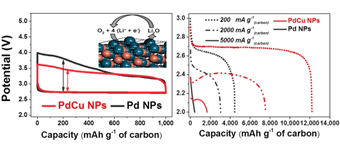
Recently, Li–O2 batteries have emerged as promising technology for electric vehicles and energy storage systems. However, there are many obstacles limiting practical applications of Li–O2 batteries, including poor power capability, short cycle life, and low energy efficiency mainly caused by their sluggish kinetics. We report on bimetallic nanoparticles having mixed atomically disordered face-centered-cubic and ordered B2-type phases, and their enhanced electrochemical performance in Li–O2 cells. (R. Choi et al. Energy Environ. Sci. 2014, 7, 1362.)
최근 논문
- “A Design of plasmonic materials on demand for improving the insufficient absorption band in organic solar cells”, S.-W. Baek, G. Park, J. Noh, C. Cho, C.-H. Lee, M-K. Seo, H. Song, J.-Y. Lee, ACS Nano, Articles ASAP (2014).
- “Anti-counterfeit nanoscale fingerprints based on randomly distributed nanowires”, J. Kim, J. M. Yun, J. Jung, H.Song, J.-B. Kim, H. Ihee, Nanotechnology 25, 155303-155309 (2014).
- “A chelating effect in hybrid ink for non-vacuum-processed CuInSe2 thin films”, A. Cho, H. Song, J. Gwak, Y.-J. Eo, J. H. Yun, K. Yoon, S. J. Ahn, J. Mater. Chem. A 2, 5087-5094 (2014).
- “Facile synthesis of multipodal MnO nanocrystals and their catalytic performance”, A. Kim, D. Shin, M. Kim, C. Yoon, H. Song, K. H. Park, Eur. J. Inorg. Chem. 8, 1279-1283 (2014).
- “Suzuki coupling reaction using hybrid Pd nanoparticles”, A. Kim, J. C. Park, M. Kim, E. Heo, H. Song, K. H. Park, J. Nanosci. Nanotechnol. 14, 1872-1883 (2014).
- “Ultra-low overpotential and high rate capability in Li-O2 batteries through surface atom arrangement of PdCu nanocatalysts”, R. Choi, J. Jung, G. Kim, K. Song, Y.-I. Kim, S. C. Jung, Y.-K. Han, H. Song, Y.-M. Kang, Energy Environ. Sci. 7, 1362-1368 (2014)
- “PEG and Carboxylate-functionalized gold nanoparticles by polymer linkages: high stability and plasmonic detection of proteins”, G. Park, D. Seo, I. S. Chung, H. Song, Langmuir 29, 13518-13526 (2013).



